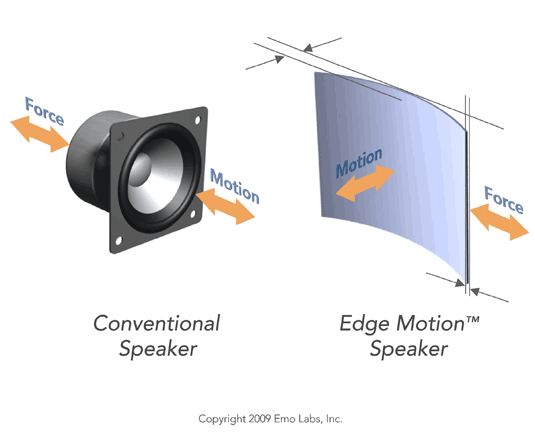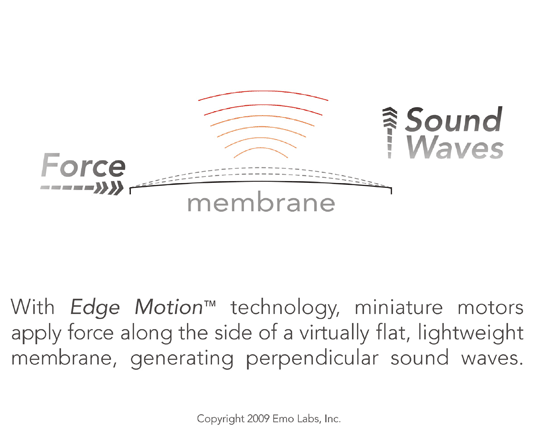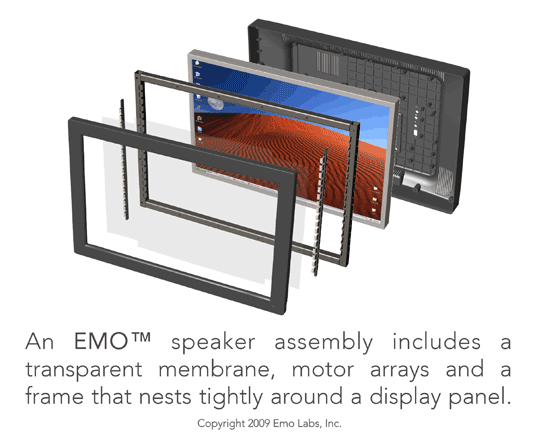These Speakers Sound Great. And They’re…Invisible!
By Harry McCracken | Monday, January 26, 2009 at 9:26 am
 I had two hands-down favorites at this year’s Consumer Electronics Show. One of them was the one that was everybody’s favorite: Palm’s upcoming Pre phone. The other was a little-known technology which I saw demoed in a private preview. It’s from a Boston-area startup called Emo Labs, and it’s a new technology for loudspeakers that called Edge Motion. Emo says that Edge Motion lets it build “invisible loudspeakers” for incorporation into TVs, computer displays, notebooks, and another devices with screens–and that its technology is the first all-new development in speaker design in decades. Judging from the sneak peek I saw, that isn’t hype.
I had two hands-down favorites at this year’s Consumer Electronics Show. One of them was the one that was everybody’s favorite: Palm’s upcoming Pre phone. The other was a little-known technology which I saw demoed in a private preview. It’s from a Boston-area startup called Emo Labs, and it’s a new technology for loudspeakers that called Edge Motion. Emo says that Edge Motion lets it build “invisible loudspeakers” for incorporation into TVs, computer displays, notebooks, and another devices with screens–and that its technology is the first all-new development in speaker design in decades. Judging from the sneak peek I saw, that isn’t hype.
Standard loudspeakers reproduce sound by moving a cone back and forth. Edge Motion does the job by using arrays of motors to wiggle the edges of a clear membrane. The motor arrays can be built into the frame that surrounds a TV, monitor, or laptops’s display, and the clear membrane sits in front of the screen–it’s a much more space-efficient approach than that of traditional speakers, since it utilizes the screen real estate that’s already there. (The bigger the screen, the bigger the membrane can be; the bigger the membrane, the better the sound.) End result: Audio quality you associate with bulky speakers without the bulk.
Here are some images from Emo that explain how it works:



The notion of a loudspeaker system that involves a bunch of motors that move a piece of plastic in front of a screen is a little hard to process mentally–at least if you know as little about audio engineering as I do. It sounds like it would be noisy and that you’d be able to see the membrane jiggling about. Nope. The demos that I heard worked wonderfully well.
Before the Emo exects I met with told me how Edge Motion works, they showed me a Diana Krall concert on an ordinary-looking medium-sized flatscreen TV, and the sound was big enough that I wondered if they’d tucked a multi-piece speaker system with a subwoofer out of sight. Another demo involving a 15-inch LCD such as the ones built into notebooks was equally impressive. Or maybe even a bit more so, since the loudspeakers embedded in notebooks usually range from abysmal to tinny-but-marginally-bearable-as-long-as-you’re-not-at-all-discriminating.
Emo plans to sell the speakers to consumer electronics manufacturers who will embed them in their products. I’m not an audiophile, and my ears aren’t always smart enough to be impressed by sound-related demos which I’m assured will impress me. But the benefits of Edge Motion were obvious the moment I listened; if it sounds as good in shipping products and doesn’t cost radically more than standard audio technology, I think it’ll be a major hit.
We’ll have to wait awhile before we know for sure: The company says that it hopes that TVs will be ready in time for Christmas, but availability might slip into 2010. Edge Motion speakers for notebooks will come along later (it’s a trickier engineering challenge to squeeze the technology into the more limited space provided by a portable computer). Over time, Emo has hopes of putting Edge Motion into just about any device that has a screen and a need for sound, including pocketable gizmos such as cell phones.
I look forward to watching (and, more important, listening) as Edge Motion makes its way into the market…
[NOTE: Commenter John Mulvaney notes that Emo’s technology looks similar to NXT’s SoundVu…I’m going to ask Emo for their input on how the technologies compare.] [FURTHER NOTE: An Emo representative says that the company has no association with NXT, and that the technologies are fundamentally different. I hope to get more details…]
31 Comments
Read more:
14 Comments For This Post
17 Trackbacks For This Post
-
Mobilez The World » Blog Archive » Emo Labs concocts its own invisible speaker technology Says:
January 27th, 2009 at 12:19 am[…] appeared on Engadget on Tue, 27 Jan 2009 02:43:00 EST. Please see our terms for use of feeds.Read | Permalink | Email this | Comments Add this to : Digg it Save […]
-
Invisible speakers not so far from reality! | New Gadgets Guru Says:
January 27th, 2009 at 12:28 am[…] to produce the sound. So if you have a bigger screen you will probably have better sound too! [Via Technologizer] Popular PostsAll new Twitter contest on NewgadgetsguruNewgadgetsguru has migrated to […]
-
Kansas city LAN Party » Blog Archive » Emo Labs concocts its own invisible speaker technology Says:
January 27th, 2009 at 12:40 am[…] appeared on Engadget on Tue, 27 Jan 2009 02:43:00 EST. Please see our terms for use of feeds.Read | Permalink | Email […]
-
Emo Labs concocts its own invisible speaker technology | TechRoo.com| Tech News, Gadget News Says:
January 27th, 2009 at 2:04 am[…] Read | Permalink | Email this | Comments […]
-
Wiot.net :: Technology :: Emo Labs concocts its own invisible speaker technology Says:
January 27th, 2009 at 2:43 am[…] Read | Permalink | Email this | Comments […]
-
Emo Labs concocts its own invisible speaker technology Says:
January 27th, 2009 at 4:41 am[…] appeared on Engadget on Tue, 27 Jan 2009 02:43:00 EST. Please see our terms for use of feeds.Read | Permalink | Email […]
-
Emo Labs concocts its own invisible speaker technology - Are you reading? Says:
January 27th, 2009 at 4:47 am[…] year, though it’ll be a bit longer before the same can happen on space-constrained laptops.Source Share and […]
-
GeekBrief.TV | Video Podcast » Blog Archive » GBTV #502 | Edge Motion, TheWrap, TechCrunch Tablet Says:
January 27th, 2009 at 9:53 am[…] Emo Labs are working on something pretty cool called Edge Motion. It’s a clear membrane on your display that’s meant to give you better sound than we currently get with our notebooks. For a full explanation of the technology in play, visit Technologizer.com. […]
-
Emo Labs concocts its own invisible speaker technology Says:
January 27th, 2009 at 10:46 am[…] Read | Permalink | Email this | Comments […]
-
jkOnTheRun » Blog Archive Your Next Notebook Display Might be a Speaker « Says:
January 27th, 2009 at 12:18 pm[…] room for speakers when you have to cram in various ports, jacks and card readers to a notebook. Harry McCracken thinks that Emo Labs might be on to something with their “invisible speakers”. From the […]
-
GBTV #502 (small) | Edge Motion, TheWrap.com, TechCrunch Tablet | TechTV Update Says:
January 27th, 2009 at 1:55 pm[…] Emo Labs are working on something pretty cool called Edge Motion. It’s a clear membrane on your display that’s meant to give you better sound than we currently get with our notebooks. For a full explanation of the technology in play, visit Technologizer.com. […]
-
Altavoces invisibles | Vooxu.com Says:
January 29th, 2009 at 7:49 am[…] Visto en Technologizer […]
-
Linkpost | 1.27.2009 | Samsung News & Info Blog Says:
January 30th, 2009 at 4:51 am[…] These Speakers Sound Great. And They’re…Invisible! – Technology from Emo Labs can get great sound from speakers built into the bezel of a notebook […]
-
Ei näy, mutta kuuluu... | Wautsi.Com Says:
February 2nd, 2009 at 4:13 am[…] Linkki:Technologizer […]
-
Ebay Rambling - Rare Finds - Unusual Auctions » Blog Archive » Bose Acoustimass 5 Series III - Great Choice On Ebay Says:
February 5th, 2009 at 8:44 am[…] These Speakers Sound Great. And They’re…Invisible! (technologizer.com) […]
-
Emo Labs’ “Invisible Speakers” | Technologizer Says:
September 22nd, 2009 at 11:03 am[…] all: News Back at the Consumer Electronics Show in January, I got a preview of Emo Labs’ technology for building nice-sounding speakers into the bezels of HDTVs (and, eventually, notebooks, phones, picture frames, and other devices), providing a high-quality […]
-
La Pantalla de tu Computadora como Bocina.. » Blog de Taller de Computo & Servicom Says:
November 6th, 2009 at 7:28 am[…] se pierde el sentido de “movilidad absoluta” al tener que cargar con más aparatos. Harry McCracken piensa que Emo Labs podrían estar en el camino correcto con el desarrollo de sus “Bocinas […]













January 26th, 2009 at 9:48 am
What happends if something like that breaks though? Also, I’m sure that at certain volumes, you MUST see that membrane vibrating? I mean come on….vibration IS movement.
I’m sure it sounds decent and is space-saving, but there are some practical issues that raise some questions still.
I know for a fact something like this wouldn’t replace surround sound or headphones.
I’d say the best application for something like this would be on small portable devices where carrying sound equipment would be impractical.
Anything else…I can see it costing a lot for larger devices, and I’m sorry but this simply cannot replace a home theater experience.
January 26th, 2009 at 10:10 am
Hi, John: I don’t think Emo is attempting to replace home theater setups. Its goal is provide better sound than the speakers typically built into TVs and other devices, while taking up less space. I was impressed…
–Harry
January 26th, 2009 at 10:17 am
@John I don’t think you understand this technology. It isn’t supposed to replace surround sound, it isn’t supposed to be the end all be-all solution. It is, however, a great space saving way for some products to have better quality sound than the tiny sized speakers that they typically come with. Because of the way that speakers work, this product helps a lot. It isn’t different from a few other devices that have used flat surfaces such as windows and tables as amplifiers: the larger the surface, the louder the sound can be with better dynamic range (to a certain extent). I look forward to this!
January 26th, 2009 at 11:11 am
Looks very like the NXT surface sound technology, I wonder if the are a licensee?
January 29th, 2009 at 10:26 pm
Can they play any kind of music or just EMO?
February 16th, 2009 at 7:49 am
I think this great and hope to one of the lucky ones to try it. Any info on how to get my hands on them.
February 16th, 2009 at 8:08 am
“End result: Audio quality you associate with bulky speakers without the bulk.”
I think not, designers of proper loudspeakers go to great lengths to engineer stiff cones which do not generate spurious signals; cone excursions are closely damped by low impedance amplifier ouputs so that the cone stops when the signal stops; cone flexure is minimised and the cone suspension also damps any vibrations in the cone itself. This present speaker design works by flexing the membrane so I would not anticipate tight control of a wobbling sheet of plastic! I do not know how the ‘motors’ work but they can’t be as direct as a speech coil in a normal loudspeaker. I assume that back movements of the membrane are vented at the sides – this lack of a cabinet or baffle will severely limit bass response as the back radiation cancels the front at low frequencies.
Finally, how will this membrane stand up to cleaning when Joe public starts wiping a greasy hand across it trying to remove coughed out coffee and bits of doughnut?
February 16th, 2009 at 9:48 am
I agree with Robert Taylor. It would take unimaginable materials tech and transducer (or “motor” in this case) control to get a sheet of anything to make hi-fi sound when moved about the edges. So this would seem at best a mid- to low-fi device. We’ll see. The good news is that most of the market doesn’t care much about realistic sound reproduction. Witness the iPod, the mp3 format, and the car as a listening room.
February 16th, 2009 at 7:21 pm
plane speaker? are they same one?
many years ago has. and another wonderful spotlight speaker with narrow radiation angle.
February 16th, 2009 at 7:52 pm
for driving these motors they will have to change the whole audio
amplification system or the approch can be to use the same signal as
available and process it to get the needed drive signal for motors also
the power specs (in terms of comsumed electrical power) can be a good
factor to consider/promote the things further
February 16th, 2009 at 9:31 pm
I found this article very interesting since back in 1994, Innovative Transducers Inc., a manufacturer of geophysical sensors since sold to the French, created several transducers that used a similar curved shaping of a constrained Piezo Polymer sheet to generate sound for use in sub-bottom marine geophysical imaging. This micro motor concept is similar in nature however the piezo polymer film changed length as opposed to pulling on the edges of a passive polymer film. ITI was approached by Draper Labs and asked to solve a rather unigue problem of creating spatial arrays of very low mass primarily as receivers. Several transducers of a gaussian shape utilizing a second order differential curvature approach were built for use in spacial arrays as detection devices. There were quite a few iterations of this concept to include devices that acted as both transmitters and recievers. Had there been a market at that time, it would have been very simple to create panels that also were optically transparent using a gold sputter technique to apply “invisible” electrodes to the polymer film. The manufacturer of the Piezo Polymer film at the time also built “talking” mylar baloons but unfortunately, they were rather expensive novelties and never really took off.
February 19th, 2009 at 2:32 pm
This device i assume need a specialised driver?, however its a great possbility to use the method as a part of a secondary glazing unit or a transparancy decor panel of some kind.
great idea
February 25th, 2009 at 9:00 am
Those speakers sound amazing. Wouldn’t mind some external to plug into my computer, or a way to wifi them to multiple devices.
March 1st, 2009 at 11:16 pm
EMO TECHNOLOGY ROFL